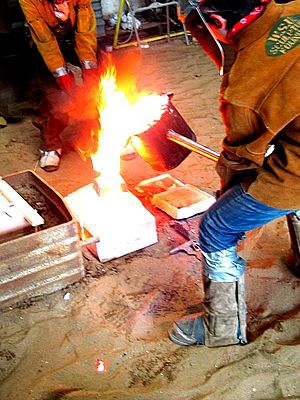Casting (metalworking) facts for kids
In metalworking, casting is a super cool way to make things! It's all about pouring hot, melted metal into a special container called a mold. When the metal cools down and gets hard, it takes the shape of the mold. The finished piece is often called a cast or a casting.
People have been using casting for thousands of years. It's a really old and important skill. It's been used to create amazing sculptures, beautiful jewellery, strong weapons, and useful tools.
Contents
What is Casting?
Casting is like making a metal ice cube! First, you melt metal until it's a liquid. Think of it like super hot soup. Then, you carefully pour this liquid metal into a mold. A mold is like a hollow shape that you want your finished item to look like.
Once the liquid metal is inside the mold, it starts to cool down. As it cools, it becomes solid again. When it's completely hard, you open the mold and take out your new metal object. This object is called a "casting."
How Does Casting Work?
The basic idea of casting is simple, but there are many steps to get it right. First, you need to design the part you want to make. Then, you create a mold that has the exact shape of that part.
The mold is super important. It needs to be strong enough to hold the hot liquid metal. It also needs to let the metal cool down properly. Sometimes, molds are made from sand, clay, or even other metals.
Making the Mold
One common way to make a mold is using sand. Special sand is mixed with a binder, which is like glue. This mixture is packed around a pattern, which is a model of the object you want to cast. Once the sand hardens, the pattern is removed, leaving a hollow space. This space is the mold!
Another way is to use a "permanent mold." These molds are made from metal and can be used over and over again. This is great for making many copies of the same item.
A Look Back: History of Casting
Casting is one of the oldest ways humans have shaped metal. People started casting thousands of years ago, even before recorded history. The earliest known castings were made from copper and bronze.
- Around 3200 BC: Ancient civilizations in Mesopotamia (modern-day Iraq) and Egypt were casting copper tools and weapons.
- Around 2000 BC: The Bronze Age began. People learned to mix copper with tin to make bronze. Bronze was stronger and easier to cast than pure copper. This led to better tools, weapons, and art.
- Around 500 BC: The Chinese mastered iron casting. They made huge iron bells and statues. This was a big step because iron is much harder to melt than bronze.
- Middle Ages: Casting continued to be important for making bells, cannons, and other large metal objects.
- Industrial Revolution: In the 1700s and 1800s, casting became even more important. It was used to make parts for steam engines, machines, and railway tracks.
Today, casting is still a vital part of manufacturing. It helps us make everything from car engines to tiny jewelry pieces.
Why is Casting Important?
Casting is super useful because it can create complex shapes. It's hard to make some shapes by bending or cutting metal. But with casting, you can pour liquid metal into almost any mold.
It's also great for making many copies of the same item. Once you have a good mold, you can use it again and again. This makes production faster and cheaper.
Many things we use every day are made by casting. Think about parts of your bicycle, engine blocks in cars, or even the metal parts of your computer. Casting helps build the world around us!
Images for kids






